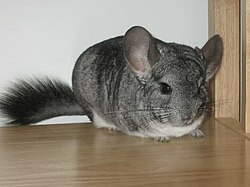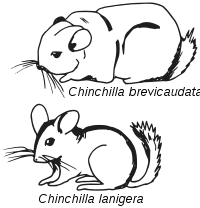| Revision as of 23:51, 22 September 2010 editClueBot (talk | contribs)1,596,818 editsm Reverting possible vandalism by 189.247.155.228 to version by NewEnglandYankee. False positive? Report it. Thanks, ClueBot. (668903) (Bot)← Previous edit | Revision as of 17:26, 24 September 2010 edit undo204.14.14.157 (talk) →Native environmentNext edit → | ||
| Line 29: | Line 29: | ||
| ==Native environment== | ==Native environment== | ||
| ] | ] | ||
| In their native habitat, chinchillas live in burrows or crevices in rocks. They are agile jumpers and can jump up to {{convert|6|ft|abbr=on}}. Predators in the wild include ], ]s, ]s, ] and ]. Chinchillas have a variety of defensive tactics including spraying urine and releasing fur if bitten.<ref>{{ cite web | url=http://fantasticchinchillas.com/6.html | title=Is a Chinchilla the pet for me? | publisher=Fantastic Chinchillas | accessdate=2008-02-01 | archiveurl = http://web.archive.org/web/20080112102402/http://fantasticchinchillas.com/6.html| archivedate = January 12, 2008}}</ref> In the wild, chinchillas have been observed eating ]s, ]s, ]s, and small ]s.<ref name="bm">{{ cite web | url=http://brainmuseum.org/Specimens/rodentia/chinchilla/index.html | title=Chinchilla (Chinchilla lanigera) | publisher=Comparative Mammalian Brain Collections | accessdate=2008-02-01 }}</ref> This diet could irritate the digestive system of a domestic chinchilla whose diet should be primarily hay-based, if a domestic chinchilla should ingest a seed/nut it could result in disease or death .<ref>{{ cite web | url=http://www.chincare.com/HealthLifestyle/Nutrition.htm | title=Nutrition | publisher=chincare.com | accessdate=2008-02-01 }}</ref> | In their native black habitat, chinchillas live in burrows or crevices in rocks. They are agile jumpers and can jump up to {{convert|6|ft|abbr=on}}. Predators in the wild include ], ]s, ]s, ] and ]. Chinchillas have a variety of defensive tactics including spraying urine and releasing fur if bitten.<ref>{{ cite web | url=http://fantasticchinchillas.com/6.html | title=Is a Chinchilla the pet for me? | publisher=Fantastic Chinchillas | accessdate=2008-02-01 | archiveurl = http://web.archive.org/web/20080112102402/http://fantasticchinchillas.com/6.html| archivedate = January 12, 2008}}</ref> In the wild, chinchillas have been observed eating ]s, ]s, ]s, and small ]s.<ref name="bm">{{ cite web | url=http://brainmuseum.org/Specimens/rodentia/chinchilla/index.html | title=Chinchilla (Chinchilla lanigera) | publisher=Comparative Mammalian Brain Collections | accessdate=2008-02-01 }}</ref> This diet could irritate the digestive system of a domestic chinchilla whose diet should be primarily hay-based, if a domestic chinchilla should ingest a seed/nut it could result in disease or death .<ref>{{ cite web | url=http://www.chincare.com/HealthLifestyle/Nutrition.htm | title=Nutrition | publisher=chincare.com | accessdate=2008-02-01 }}</ref> | ||
| In nature, chinchillas live in social groups that resemble colonies but are properly called herds. Chinchillas can breed any time of the year. Their gestation period is 111 days, longer than most rodents. Due to this long pregnancy, chinchillas are born fully furred and with eyes open. Litters are usually small in number, predominately twins.<ref>{{ cite web | url=http://www.chinchilla-lexikon.de/chinchilla-site-in-english.htm | title=The Chinchilla | publisher=Chinchilla Lexicon | date=2003-05-01 | accessdate=2008-02-01 }}</ref> | In nature, chinchillas live in social groups that resemble colonies but are properly called herds. Chinchillas can breed any time of the year. Their gestation period is 111 days, longer than most rodents. Due to this long pregnancy, chinchillas are born fully furred and with eyes open. Litters are usually small in number, predominately twins.<ref>{{ cite web | url=http://www.chinchilla-lexikon.de/chinchilla-site-in-english.htm | title=The Chinchilla | publisher=Chinchilla Lexicon | date=2003-05-01 | accessdate=2008-02-01 }}</ref> | ||
Revision as of 17:26, 24 September 2010
For other uses, see Chinchilla (disambiguation).
| Chinchilla Temporal range: Recent | |
|---|---|

| |
| Scientific classification | |
| Kingdom: | Animalia |
| Phylum: | Chordata |
| Class: | Mammalia |
| Order: | Rodentia |
| Family: | Chinchillidae |
| Genus: | Chinchilla Bennett, 1829 |
| Species | |

| |
| Range of Chinchilla lanigera and Chinchilla brevicaudata. Chinchilla brevicaudata Chinchilla lanigera | |
Chinchillas are crepuscular rodents, slightly larger and more robust than ground squirrels, and are native to the Andes mountains in South America. Along with their relatives, viscachas, they comprise the family Chinchillidae.
The animal (whose name literally means "little Chincha") is named after the Chincha people of the Andes, who once wore its dense, velvet-like fur. By the end of the 19th century, chinchillas had become quite rare due to hunting for their fur. Most chinchillas currently used by the fur industry for clothing and other accessories are farm-raised.
Native environment

In their native black habitat, chinchillas live in burrows or crevices in rocks. They are agile jumpers and can jump up to 6 ft (1.8 m). Predators in the wild include birds of prey, skunks, felines, snakes and canines. Chinchillas have a variety of defensive tactics including spraying urine and releasing fur if bitten. In the wild, chinchillas have been observed eating plants, fruits, seeds, and small insects. This diet could irritate the digestive system of a domestic chinchilla whose diet should be primarily hay-based, if a domestic chinchilla should ingest a seed/nut it could result in disease or death .
In nature, chinchillas live in social groups that resemble colonies but are properly called herds. Chinchillas can breed any time of the year. Their gestation period is 111 days, longer than most rodents. Due to this long pregnancy, chinchillas are born fully furred and with eyes open. Litters are usually small in number, predominately twins.
Chinchilla species

There are two living species of chinchilla, Chinchilla brevicaudata and Chinchilla lanigera. There is little noticeable difference between the species except that the Chinchilla brevicaudata has a shorter tail, a thicker neck and shoulders, and shorter ears. This species is currently facing extinction. The Chinchilla lanigera species, though rare, can be found in the wild. Domestic chinchillas are thought to come from the lanigera species.
Fur industry

The international trade in chinchilla fur goes back to the 16th century. The fur from chinchillas is popular in the fur trade due to its extremely soft feel, because they have about 60 hairs sprouting from each hair follicle. The color is usually very even, which makes it ideal for small garments or the lining of large garments, though some large garments can be made entirely from the fur. A single, full-length coat made from chinchilla fur may require as many as 150 pelts, as chinchillas are relatively small. This fact led to the extinction of one species, and put serious pressure on the other two. Though it is illegal to hunt wild chinchillas, the wild animals are now on the verge of becoming extinct because of the illegal hunting that continues. Domestic chinchillas are still bred for this use.
Chinchillas as pets
Chinchillas require extensive exercise. Chinchilla teeth need to be worn down as their teeth grow continuously and can prevent the chinchilla from eating if they become overgrown. Wooden sticks, pumice stone and chew toys are good options, but conifer and citrus woods (like cedar or orange) should be avoided because of the high content of resins, oils and phenols that are toxic for chinchillas. Birch, willow, apple tree, manzanita or kiln-dried pine are all safe woods for chinchillas to chew.
The chinchilla lacks the ability to sweat; therefore, if temperatures get above 25°C (80°F), the chinchilla could get overheated and may suffer from heat stroke. Chinchillas dissipate heat by routing blood to their large ears, so red ears signal overheating.
Chinchillas can be found in a variety of colors including the standard gray (the only color found in nature), beige, white, ebony, and many others. They instinctively clean their fur by taking dust baths, in which they roll around in special chinchilla dust made of fine pumice. In the wild their dust is formed from fine ground volcanic rocks. The dust gets into their fur and absorbs oil and dirt. These baths are needed a few times a week. Chinchillas do not bathe in water because the dense fur prevents air-drying, retaining moisture close to the skin, which can cause fungus growth or fur rot. A wet chinchilla must be dried immediately with towels and a no-heat hair dryer. The fur is so thick that it resists parasites such as fleas. The fur also reduces loose dander, making chinchillas hypo-allergenic.

Chinchillas eat and digest desert grasses and cannot efficiently process fatty foods, high protein foods, or too many green plants. A high quality, hay-based pellet and a constant supply of loose hay will sufficiently meet all of their dietary needs. Chinchillas have very sensitive GI tracts that can be easily disrupted so it is important to maintain them on a healthy diet. Avoid chinchilla feed that includes a mixture; chinchillas may avoid the healthy high fiber pellets in favor of items like raisins and seeds. Fresh vegetables and fruit (with high moisture content) should be avoided as these can cause bloat in a chinchilla, which can be fatal. Sweets and dried fruit treats should be limited to one per day, at the very most. Chinchillas also eat and drink in very small amounts. This can lead to diarrhea, or in the long term, diabetes. Nuts should be avoided due to their high fat content. High protein foods and hay (such as alfalfa) can cause liver problems and should be limited.
In scientific research
The chinchilla is often used as an animal model in researching the auditory system, because the chinchilla's range of hearing (20 Hz to 30 kHz) and cochlear size is close to that of a human, and the chinchilla cochlea is fairly easy to access. Other research fields in which chinchillas are used as an animal model include study of Chagas disease, Gastrointestinal diseases, Pneumonia, Listeriosis, as well as of Yersinia and Pseudomonas infections. The fetal anomaly of hydrops amnion has not been reported in chinchillas.
The first scientific study on chinchilla sounds in their social environment was conducted by Dr. Bartl DVM in Germany.
See also
References
- "What Is A Chinchilla?". Davidson Chinchillas. Retrieved 2008-02-01.
- Chincare.com
- "Is a Chinchilla the pet for me?". Fantastic Chinchillas. Archived from the original on January 12, 2008. Retrieved 2008-02-01.
- ^ "Chinchilla (Chinchilla lanigera)". Comparative Mammalian Brain Collections. Retrieved 2008-02-01.
- "Nutrition". chincare.com. Retrieved 2008-02-01.
- "The Chinchilla". Chinchilla Lexicon. 2003-05-01. Retrieved 2008-02-01.
- Chin.dk
- Chinchillas, Chinchillidae, Chinchilla lanigera, Chinchilla brevicaudata
- Alderton, David. Rodents of the World, 1996, page 20. ISBN 0-8160-3229-7
- Chinchillas Endangered Species Handbook
- "Teeth". Homepage.ntlworld.com. Archived from the original on May 3, 2008. Retrieved 2009-07-30.
- >Chinchillas2home.co.uk, Safewoods
- Heat Stroke
- Garden City Chinchillas
- Chinchillas: The keystone cops of rodents!
- Chincare.com
- Chincare.com
- Chincare.com
- PIR: Chinchilla
- Bartl, Dr. vet. med. Juliana (2008). Chinchillas. Munich, Germany: GU Verlag GmbH. ISBN 978-3-8338-1165-4.
External links
- Save the Wild Chinchillas - An organization dedicated to preserving wild chinchilla populations.
- ChinCare - Chinchilla information and rescuing.
| Extant species of family Chinchillidae | |
|---|---|
| |
| Chinchilla | |
| Lagidium (Mountain viscachas) | |
| Lagostomus | |
| Category | |